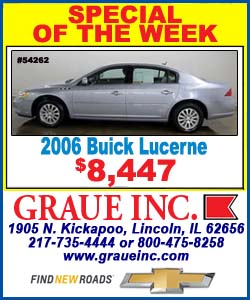 Approximately 40 students from the two history classes of Ms. Marla
Williams toured the Lincoln art and artifacts at the State Bank of
Lincoln facility on Wednesday. Approximately 40 students from the two history classes of Ms. Marla
Williams toured the Lincoln art and artifacts at the State Bank of
Lincoln facility on Wednesday.In addition, the students heard
facts about President Abraham Lincoln from historian Paul Gleason
and learned about some of the city of Lincoln landmarks from
committee member Wanda Lee Rohlfs. Then Mary Ellen Martin gave the
students a tour of the Logan County Genealogical & Historical
Society building.
Because the group consists of two classes and was quite large,
they were divided, with half the kids starting their tour at the
State Bank and the other half visiting the historical society first.
State Bank representative Susan Hurley led the kids through the
many Lincoln exhibits in the bank. She told them about pieces of
history from Abraham Lincoln's life. Among the many things she
talked about, she shared that in general, before he was
assassinated, Lincoln was not in good health, and many feared that
he didn't have long to live anyway.

She also shared with the kids that the final attack that took
Lincoln's life was not the first attempt. In all, it is believed
that there were at least six attempts on the president's life prior
to that dreadful night at Ford's Theatre.
She recounted one incident when the president returned home from
a visit with Gen. Grant and found there was a bullet hole right
above his hairline in his tall stovepipe hat. On another occasion,
Lincoln was riding in a carriage, and at a fork in the road, the
carriage went to the right and ambushers were waiting on the road
that went to the left.
Hurley also told the students that when Lincoln died, people came
seeking a remembrance of the president. In those days, locks of hair
were commonly taken for that purpose. She said so many people took
locks that there was very little hair remaining on the back of his
head after his death.
Hurley also talked to the students about how one man made a huge
difference in the world as it is today. She talked about how the
history of the country is primarily divided into "before Lincoln"
and "after Lincoln." She said, had the South won the war, the map of
the U.S. would be very different, looking much more like Europe,
with small countries. She asked the kids, if that had been the case,
would the U.S. have been the superpower it is today? Would it have
been able to stand against the Nazi movement of World War II?
Then Rohlfs talked to the students about the Postville Courthouse
and how the building that stands there today is not the original.
She related to the students, though, that her great-grandparents
lived in the original Postville Courthouse when it was no longer a
working courthouse in Lincoln.
She also brought up the fact that the students are doing a penny
drive to help the statue committee raise funds for the life-size
statue that will one day soon stand on the current courthouse
square. She gave the students a collection of pennies for their
drive.

Next, the group learned more about the statue they are raising
money for. The State Bank purchased the second replica that was made
of the statue. More replicas are being produced and sold to help
raise funds for the larger version. Rohlfs recounted the speech
Lincoln made on the courthouse square in Lincoln on Oct. 16, 1858,
and noted that the students were taking their tour on the 155th
anniversary of that speech. She explained that the statue is a
reproduction of Lincoln giving that speech.
The teacher, Ms. Williams, also shared that in the first week of
the penny drive, the students have collected $94 to give to the
statue committee.
Paul Gleason also spoke to the kids about the history of Abraham
Lincoln and the city of Lincoln. He encouraged the kids to keep
track of everyone who gives money to their "Looking for Lincoln
Penny Collection" fundraiser.
He recounted to the kids that when he was a child, the school
kids of Logan County collected pennies, nickels and dimes to build
the replica of the Postville Courthouse. He said the list of every
kid who contributed was saved and is now a part of the courthouse
history.
[to top of second column] |

Gleason also provided information about the artists who have drawn
and painted some of the art hanging in the State Bank, and about the
masks that are also part of the bank's collection.
By the time Gleason was finished, the students who had been at
the historical society building had arrived at the bank. Rohlfs took
the full group outside the bank, showed them the signs with historical
information and explained their significance for the city of Lincoln as
well as for Abraham Lincoln.
The group then split into two parts again, and those who had
toured the bank moved on to visit with Mary Ellen Martin and JoAnne
Marlin at the Logan County Genealogical & Historical Society center.
At that building, on the other side of the tracks, the group was
greeted by the two women. Mrs. Martin then gave a tour of the
building, talking extensively about what genealogy is and why it can
be important to the children.
Ms. Williams shared that earlier in the school year the students
had an assignment that related to tracking their own family history.
Martin praised them all for what she knew was good work and
advised them to save their papers from that assignment. She told the
students that type of information would be important to them as they
matured, and they might want to even add to the information as time
passes, keeping it up-to-date.
The kids enjoyed looking at many of the antique items on display
in the main room of the building, and much discussion went on about
what things were and how they were used in the olden days.

Martin shared an interesting story about a photo in an antique
frame that was given to the society. At a later date another photo
of a young woman in a lovely white dress and the actual dress were
also given to the society. Even later it was learned that the man in
the first photo was the father of the young woman. So even though
the pieces had arrived at different times from different sources,
the family was now together again and on display at the society's
building.
The children were also divided into smaller groups and allowed to
go inside the "Lincoln Room" and see items on display that reflected
Abraham Lincoln and that era of our nation's history.
Ms Williams' two classes are competing to see who can raise the
most money in their penny drive for the statue committee. At the end
of the drive, the school principal, Mr. Allen, has promised to buy
pizza for the winning group.
The classes are also planning another fundraiser in the future.
"Hiking for History" will be a walking event similar to Relay For
Life and will take place in the gymnasium at Northwest School.
The committee for the statue is very happy to see the youth of
the area take an interest in helping them raise funds for the statue
that will be on the downtown courthouse lawn. They are hopeful that
other schools and classes will be motivated to also take interest in
the statue and will want to participate in similar educational
tours.
Anyone else who is interested in donating to the statue fund or
would like to own a 24-inch replica of the statue can learn more
about how to do this by contacting the Logan County Genealogical &
Historical Society in Lincoln.
[By NILA SMITH]

Logan County Genealogical &
Historical Society
Address:
114 N. Chicago St., Lincoln, IL 62656
Hours:
Tuesday, Thursday and Friday, 11 a.m.-4 p.m.
Second and fourth Saturday, 10 a.m.-1 p.m.
Phone:
217-732-3200
Email:
lcghs1@hotmail.com
Website:
http://www.logancoil-genhist.org/
|